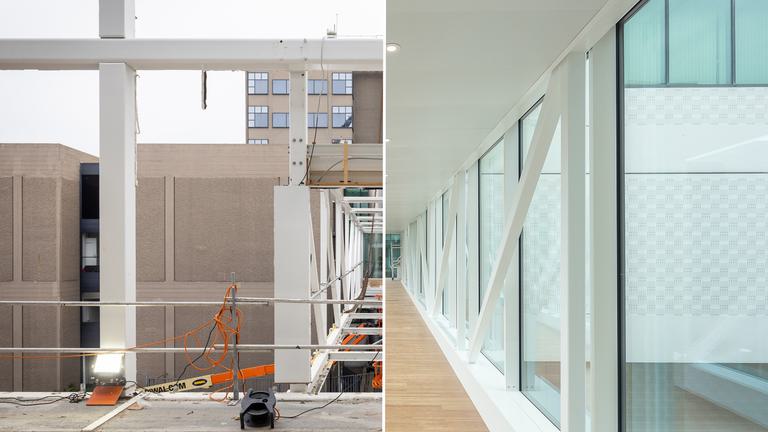On a building site on Fred. Roeskestraat in Amsterdam stands a steel framework. Apparently of a building in the making, but appearances are deceptive. It is in fact the Temporary Court Amsterdam, which has been carefully dismantled by Lagemaat BV in recent months, making the construction visible again. Phase 2 of a special project is nearing completion. A unique third phase is about to begin.
not demolition but dismantling
Demolition. That usually is phase 2 in the life cycle of a building and regularly meets with resistance. At the Temporary Amsterdam Court, however, the second phase was greeted with applause. In fact, it was clear from day one that the building would disappear again after five years. The approach was to proceed as circularly as possible, with as little waste as possible. The cepezed architects, therefore, did not go for demolition, but for dismantling. They even gave the building a third phase in its life: it can be reassembled. And that is exactly what is about to happen.
saving 2,000 tonnes of CO2
Unlike other buildings that cease to exist after demolition, the Temporary Court Amsterdam is being carefully dismantled and reassembled at a different location. The new location is Kennispark Twente in Enschede, where it will serve as a business centre. Although the layout of the building is flexible, the floor plan of the courthouse is practically adopted. Only the footbridge and the cell complex will be removed.
It is the first time in the Netherlands that a building of this size and stature, specifically designed for disassembly, is actually taken apart and reassembled elsewhere. By moving the building instead of demolishing it and opting for comparable new construction, some two thousand tonnes of CO2 will be saved.
Amsterdam Architecture Prize in Enschede
The design of the Temporary Court Amsterdam was awarded the Golden AAP by the jury of the Amsterdam Architecture Prize (AAP) in 2017. This makes it the first building to win the Amsterdam Architecture Prize that will no longer stand in the capital.
example project
Commissioned by the Government Property Agency, cepezed designed a representative house for the judiciary that was also sustainable. Now that the 'detachability' and flexibility of the building have proven themselves, the Temporary Court Amsterdam is regarded as an exemplary project in the field of circular construction.
Du Prie bouw & ontwikkeling and cepezedprojects took care of the first construction. Lagemaat BV is currently dismantling the building, transporting it to Enschede and remounting it.
demontage Tijdelijke Rechtbank Amsterdam nadert einde



Other special circular projects
show must go on
With Lagemaat BV, cepezed also works on other circular projects. Together, they investigate the possibility of moving the Zuiderstrandtheater in Scheveningen to another location.
dismantling non-demountable building
And Lagemaat is going to dismantle the old provincial government building of Gelderland, an old concrete colossus in Arnhem that was never designed to be dismantled. With the reusable concrete parts, cepezed is designing a 'knowledge centre for circular construction and demolition', commissioned by Lagemaat.
low-stress building, because it can be done
Du Prie bouw & ontwikkeling and cepezedprojects won the tender for a temporary care centre in the PI Scheveningen. Based on cepezed's circular design, a low-nitrogen construction can be realized right next to a Natura 2000 area - under the old and much stricter rules. "The National Real Estate Company holds on to the low-nitrogen construction. Because it was not only pleasantly surprised by what is possible. It also wants to contribute to the development of knowledge and experience in this field."
→ Mail bd@cepezed.nl or call our business development team on +31 (0)15 2150000